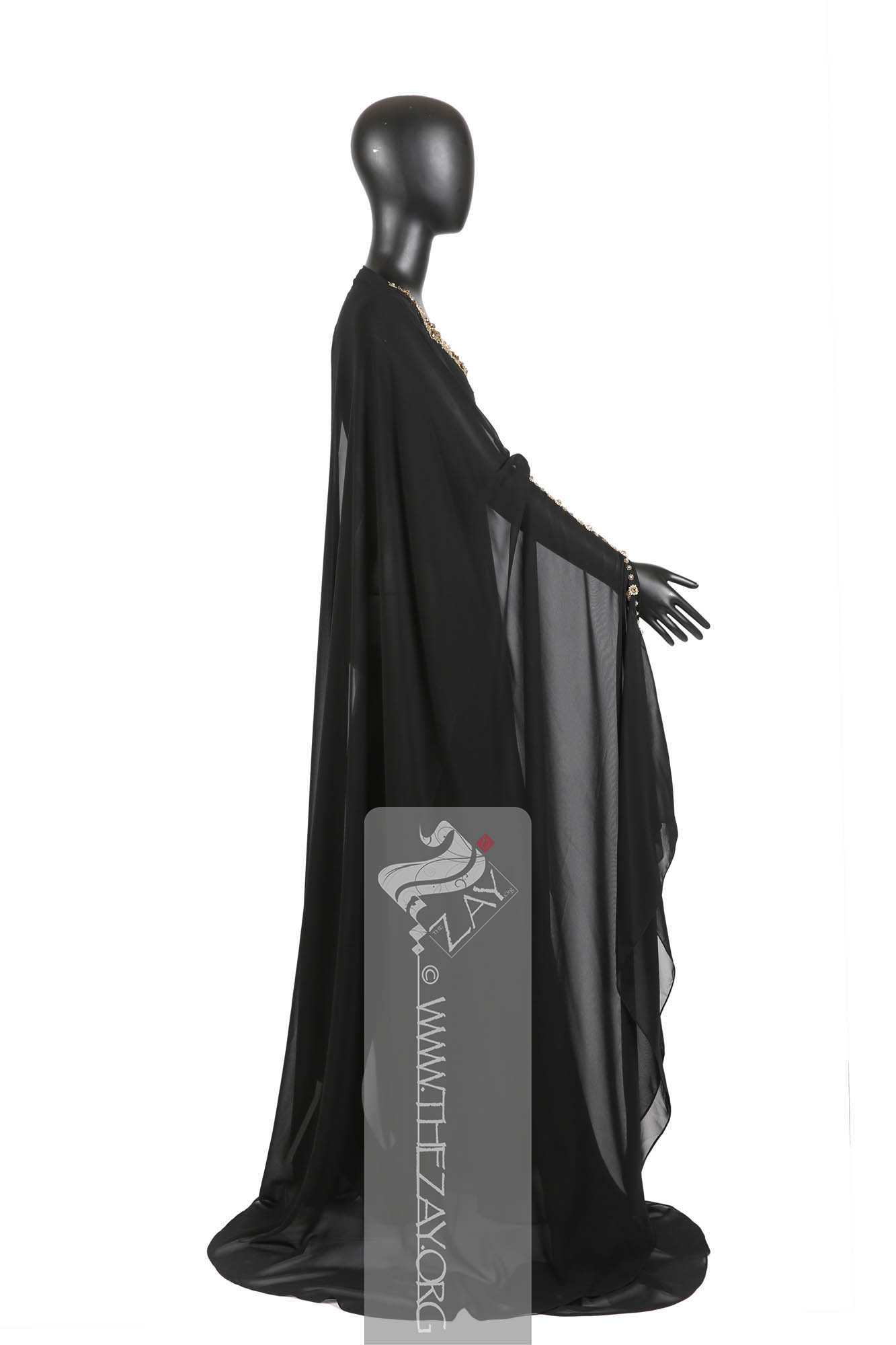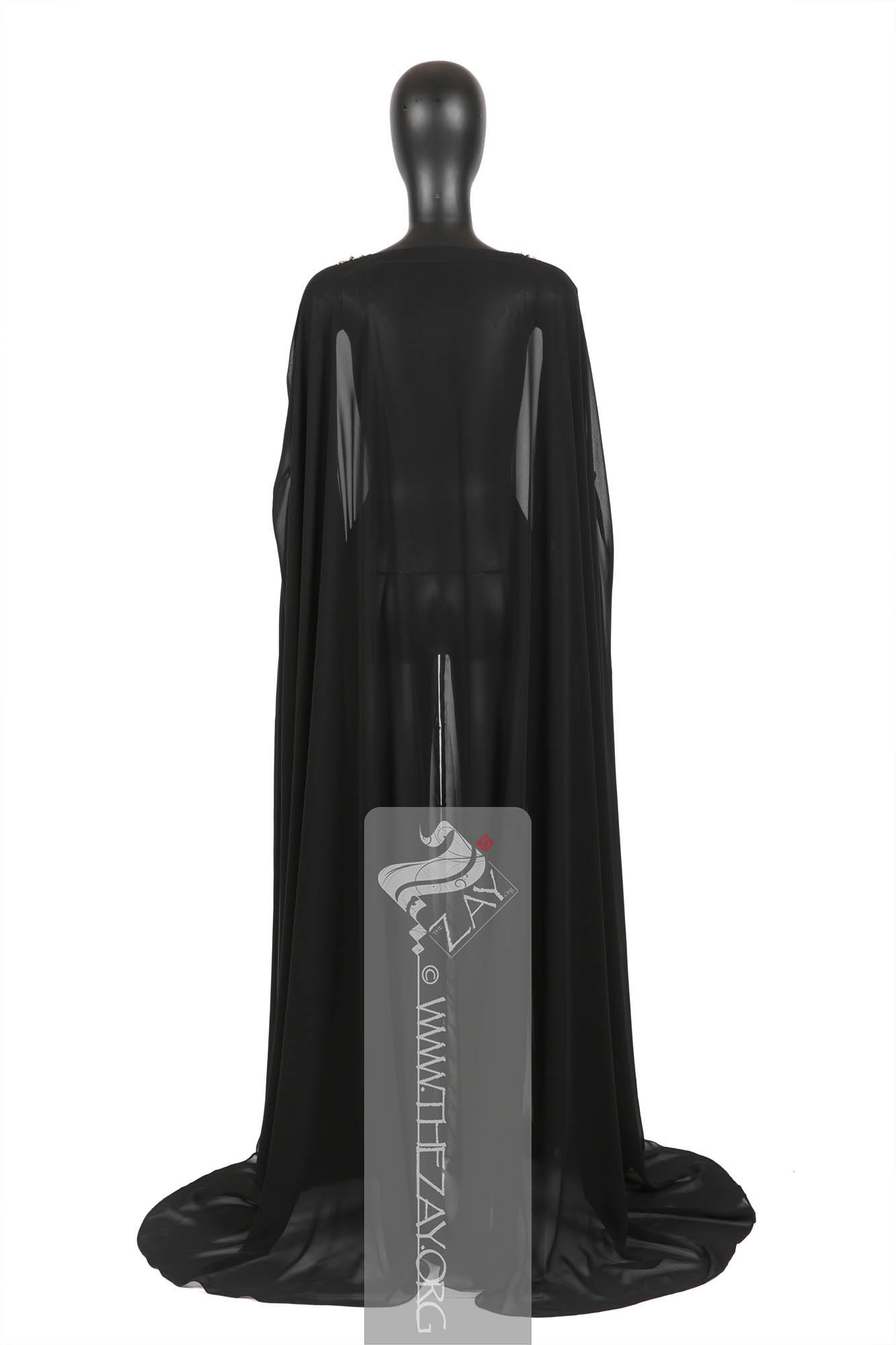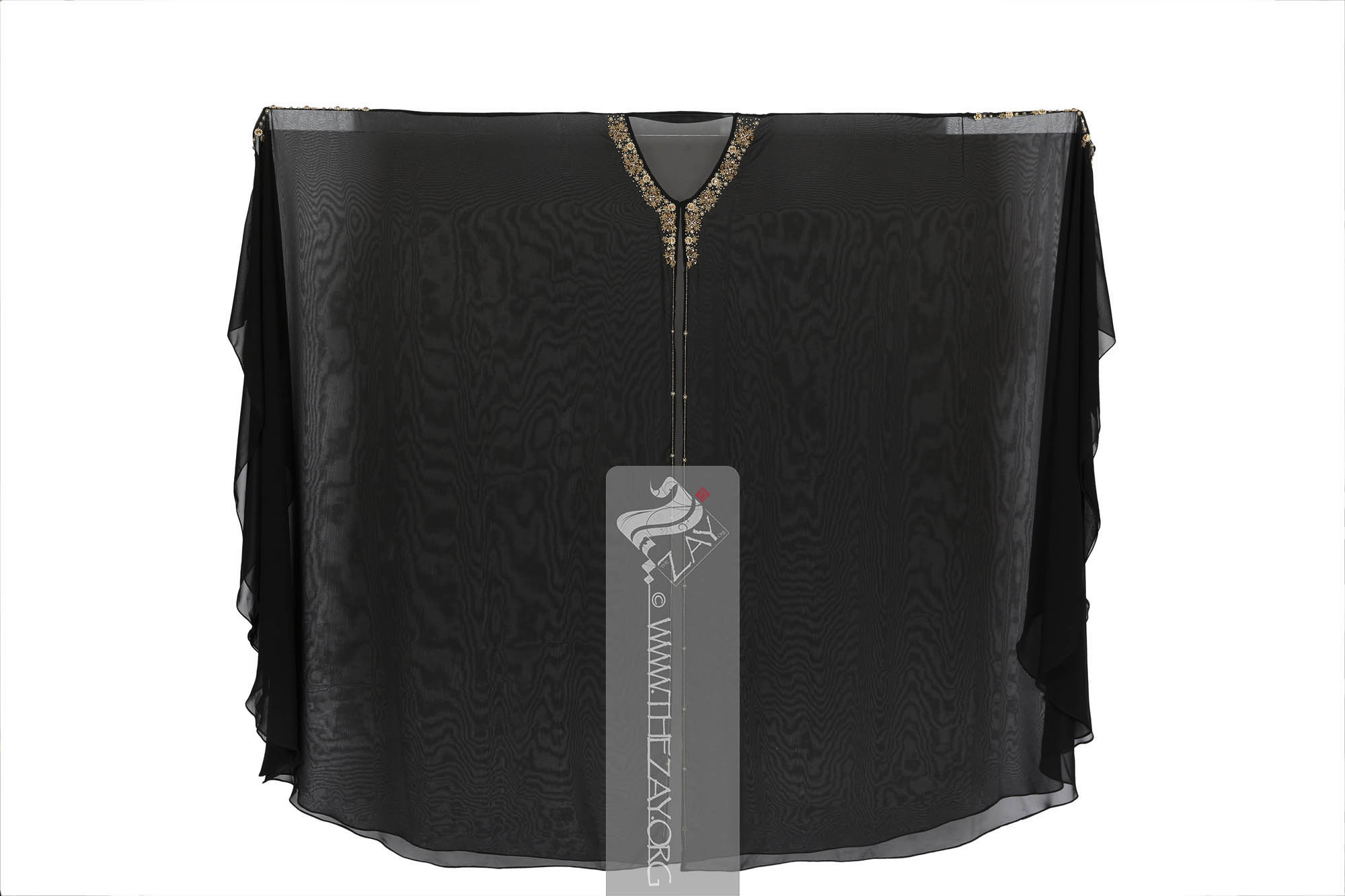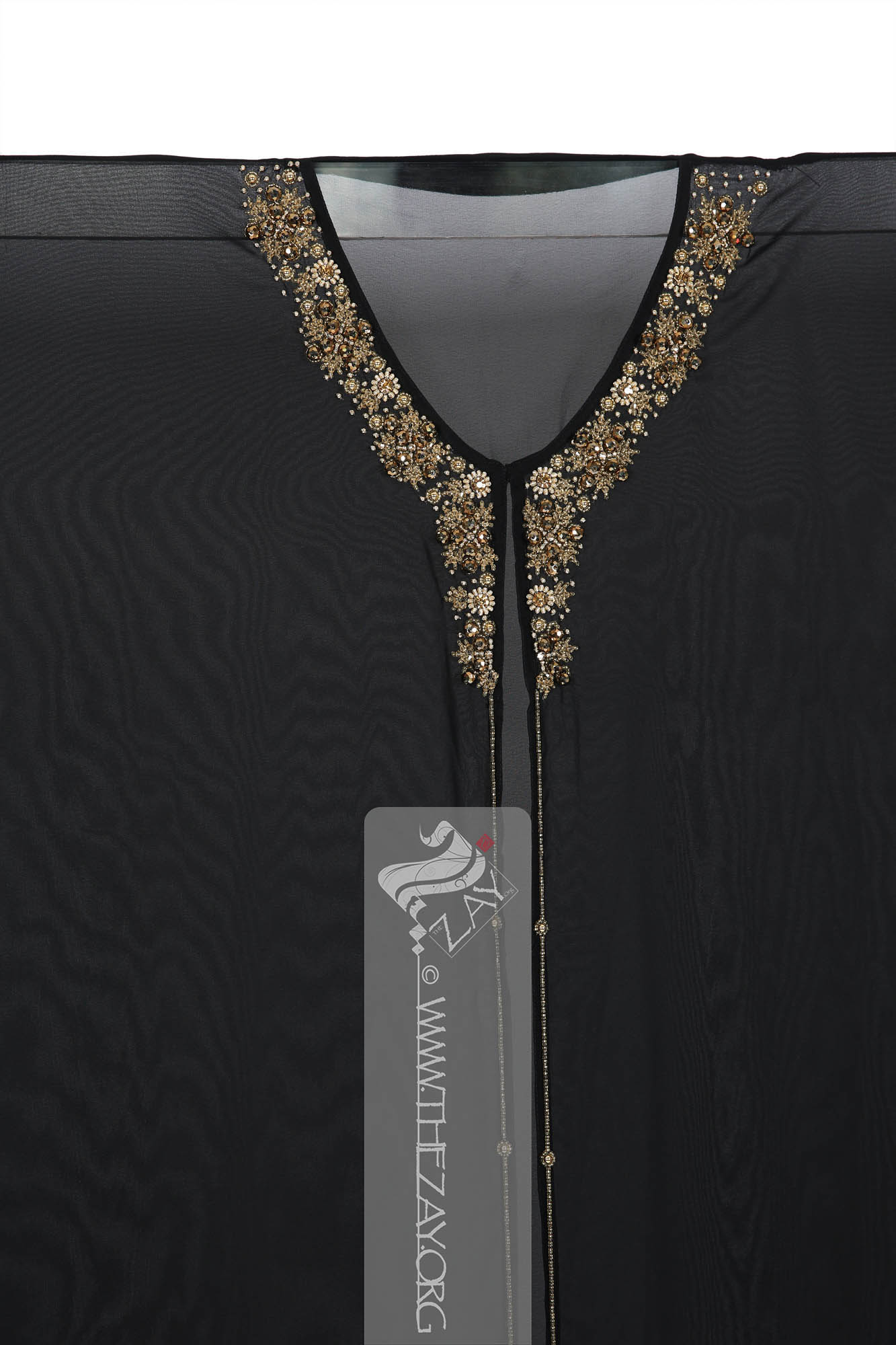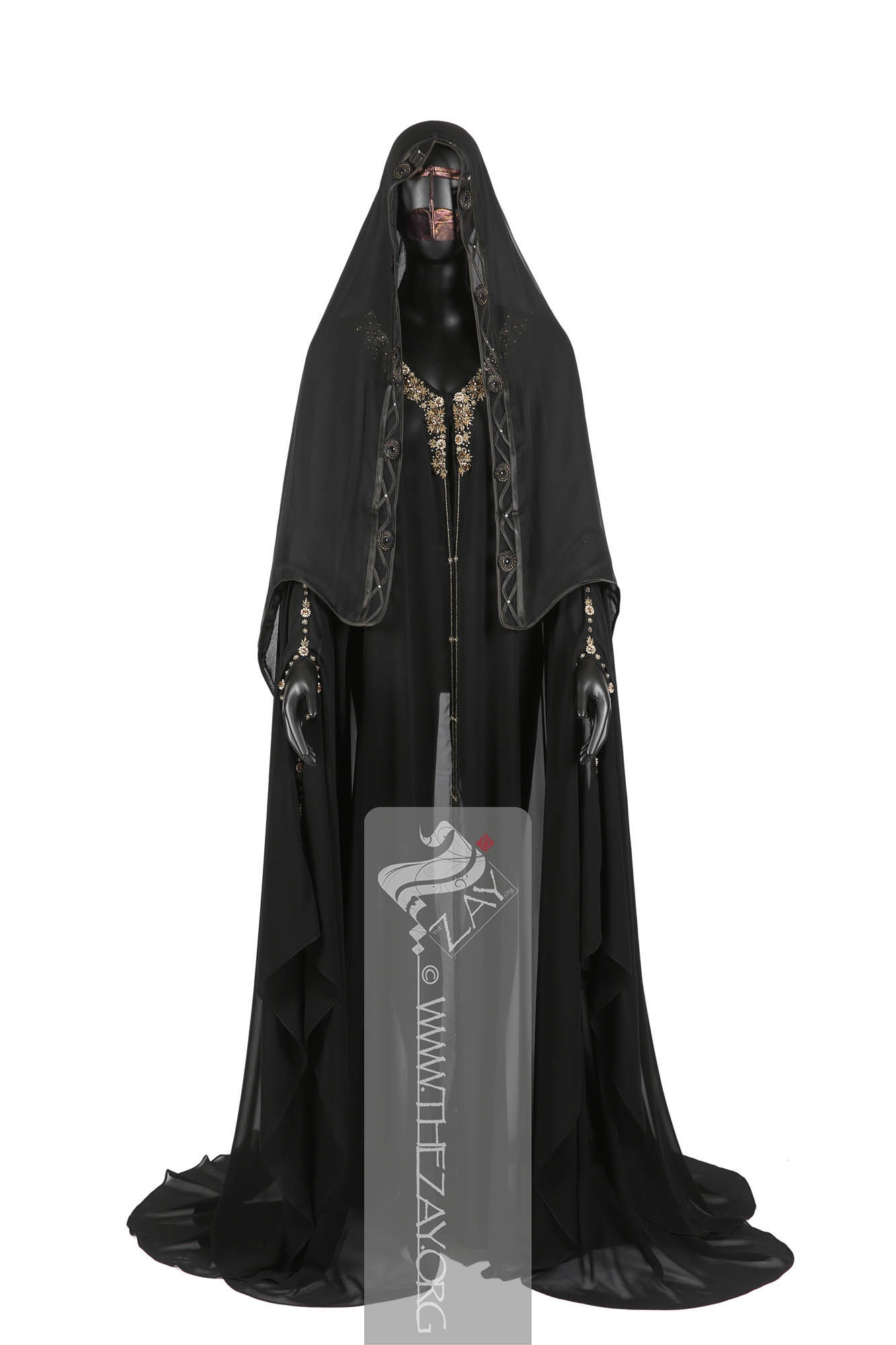Beaded cloak - UAE
| Local Name | Abayah |
| Object Category | Cloak |
| Gender | Female |
| Date of object | 1990 |
| Place Of orgin | United Arab Emirates |
| Region | Abu Dhabi |
| Object Range | United Arab Emirates |
| Dimensions | Length: 117 cm Width: 120 cm |
| Materials | Silk |
| Technique | Machine Stitched Embellished |
| Color | |
| Motif | Floral |
| Provenance | Donated, Moza al Mansuri, Abu Dhabi 1990 |
| Location | Traditional Dress House, Al Shindagha Museum, Dubai, UAE |
| Status | On loan |
| ZI number | ZI1990.500392 UAE |
Object History
This cloak (abayah
‘Abāyah: (Arabic: cloak, Pl. ‘abāyāt, or ‘Ibī. In Classical Arabic: ‘abā’ah, pl: ‘abā’āt, synonyms: ‘Abā, ‘abāh, ‘abāt, dafah
Daffah : (Arabic: side, synonyms: ‘Abā, ‘abāyah, ‘abāh, ‘abāt, bisht or mishlaḥ), long, wide, and sleeveless outer cloak worn in public by both sexes. In time this article of dress evolved and changed in shape, style, and function., bisht, or mishlaḥ), long, wide, and sleeveless outer cloak worn in public by both sexes. In time this article of dress evolved and changed in shape, style, and function.) was donated to The Zay
Zay: (Arabic: costume, Pl. azyaā’), a set of clothes in a style typical of a particular country or historical period. Initiative by Moza al Mansuri, a BS graduate of al Ain university and school headmistress in Abu Dhabi. She is married to her paternal cousin and has 3 daughters and 2 sons. Moza ordered it from a tailor for a wedding and subsequently wore it a few more times at various large formal gatherings.
Object Features
This type of cloak (abayah
‘Abāyah: (Arabic: cloak, Pl. ‘abāyāt, or ‘Ibī. In Classical Arabic: ‘abā’ah, pl: ‘abā’āt, synonyms: ‘Abā, ‘abāh, ‘abāt, dafah
Daffah : (Arabic: side, synonyms: ‘Abā, ‘abāyah, ‘abāh, ‘abāt, bisht or mishlaḥ), long, wide, and sleeveless outer cloak worn in public by both sexes. In time this article of dress evolved and changed in shape, style, and function., bisht, or mishlaḥ), long, wide, and sleeveless outer cloak worn in public by both sexes. In time this article of dress evolved and changed in shape, style, and function.) was meant to be worn in public and social ceremonies or events such as weddings. According to Emirati traditions, women customarily do not remove their abayah
‘Abāyah: (Arabic: cloak, Pl. ‘abāyāt, or ‘Ibī. In Classical Arabic: ‘abā’ah, pl: ‘abā’āt, synonyms: ‘Abā, ‘abāh, ‘abāt, dafah
Daffah : (Arabic: side, synonyms: ‘Abā, ‘abāyah, ‘abāh, ‘abāt, bisht or mishlaḥ), long, wide, and sleeveless outer cloak worn in public by both sexes. In time this article of dress evolved and changed in shape, style, and function., bisht, or mishlaḥ), long, wide, and sleeveless outer cloak worn in public by both sexes. In time this article of dress evolved and changed in shape, style, and function. in public and usually, cloaks are worn draped off the head (abayat_ras
‘Abāyat_rās: (Arabic: ‘abāyah, ‘aba: outer cloak, rās: head), in most of the Arab Gulf region the term is used when an outer cloak (‘abāyah) is worn draped off the head.), engulfing the body and obscuring the inner garments.
By the late 1970s women used sheerer silk for the abayat_ras
‘Abāyat_rās: (Arabic: ‘abāyah, ‘aba: outer cloak, rās: head), in most of the Arab Gulf region the term is used when an outer cloak (‘abāyah) is worn draped off the head., they lifted and gathered it up to their waistline, and over their wrists, and this became known as (abayah_shel
‘Abāyah_shel: (Arabic: ‘Abāyah: outer cloak, shel: to carry), colloquially in the UAE the terms refer to the outer cloak when worn draped off the head (‘Abāyat_rās), then gathered on both arms lifting it to the waistline similar to draping a shawl
Shawl: (Persian: shāl from Hindi: duśālā – Shoulder Mantle), a shawl is a South Asian version of a scarf
Scarf: (English), usually a rectangular piece of cloth loosely worn over the shoulders, upper body and arms, and sometimes also over the head. worn or wrapped loosely over the shoulders and is usually made of wool. , leaving the skirt part of the garment underneath to be visible.). Wearing the abayah
‘Abāyah: (Arabic: cloak, Pl. ‘abāyāt, or ‘Ibī. In Classical Arabic: ‘abā’ah, pl: ‘abā’āt, synonyms: ‘Abā, ‘abāh, ‘abāt, dafah
Daffah : (Arabic: side, synonyms: ‘Abā, ‘abāyah, ‘abāh, ‘abāt, bisht or mishlaḥ), long, wide, and sleeveless outer cloak worn in public by both sexes. In time this article of dress evolved and changed in shape, style, and function., bisht, or mishlaḥ), long, wide, and sleeveless outer cloak worn in public by both sexes. In time this article of dress evolved and changed in shape, style, and function. in this way revealed the lower part of the undergarment that was generally heavily adorned. From the 1980s onwards, with the introduction of the more stylized off the shoulder cloak (abayat_chatif
‘Abāyat_chatif: (Arabic: ‘Abāyah: outer cloak, chatif: Katif: shoulder), in most of the Arab Gulf region the term is used when an outer cloak (‘Abāyah) is worn draped off the shoulders. Colloquially, the letter (kāf) is pronounced (cha) in many Arab dialects.), they started to select the sheerest of cloaks (ibi
‘Ibī: (Arabic: pl. for ‘Abā: outer cloak, synonyms: ‘Abā, ‘abāyah, ‘abāh, ‘abāt, daffah, bisht or mishlaḥ), public outer cloak worn by both sexes. In time this article of dress evolved and changed in shape, style, and function.) in order to allow the ornate garments underneath to be revealed. Others resorted to keeping the front parting open to allow the frontal panel of their inner gown to be visible, thus focusing all decorative adornment on to this visible section of the garment.
Eventually, many women became less interested in showing the dress underneath, focusing instead on the design and embellishment of the cloak (abayah
‘Abāyah: (Arabic: cloak, Pl. ‘abāyāt, or ‘Ibī. In Classical Arabic: ‘abā’ah, pl: ‘abā’āt, synonyms: ‘Abā, ‘abāh, ‘abāt, dafah
Daffah : (Arabic: side, synonyms: ‘Abā, ‘abāyah, ‘abāh, ‘abāt, bisht or mishlaḥ), long, wide, and sleeveless outer cloak worn in public by both sexes. In time this article of dress evolved and changed in shape, style, and function., bisht, or mishlaḥ), long, wide, and sleeveless outer cloak worn in public by both sexes. In time this article of dress evolved and changed in shape, style, and function.) itself, as in the case with this example from the 1990s, demonstrating the true evolution of the abayah
‘Abāyah: (Arabic: cloak, Pl. ‘abāyāt, or ‘Ibī. In Classical Arabic: ‘abā’ah, pl: ‘abā’āt, synonyms: ‘Abā, ‘abāh, ‘abāt, dafah
Daffah : (Arabic: side, synonyms: ‘Abā, ‘abāyah, ‘abāh, ‘abāt, bisht or mishlaḥ), long, wide, and sleeveless outer cloak worn in public by both sexes. In time this article of dress evolved and changed in shape, style, and function., bisht, or mishlaḥ), long, wide, and sleeveless outer cloak worn in public by both sexes. In time this article of dress evolved and changed in shape, style, and function..
The hand beading embellishment (shak
Shak: (Arabic: to prick with a needle), Colloquially in the Arab gulf region it refers to the art of hand embellishing garments with beads.) on this garment was completed using different shaped golden beads. In addition, the decorative neckline (halj
Ḥalj: (Arabic: ḥalq: mouth, pl: ḥlūj,). Colloquially, the term refers to the neckline opening. The letter (qāf) is turned (jīm) in many Arab dialects.) is accentuated with an extended embroidery line down the front part of the abayah
‘Abāyah: (Arabic: cloak, Pl. ‘abāyāt, or ‘Ibī. In Classical Arabic: ‘abā’ah, pl: ‘abā’āt, synonyms: ‘Abā, ‘abāh, ‘abāt, dafah
Daffah : (Arabic: side, synonyms: ‘Abā, ‘abāyah, ‘abāh, ‘abāt, bisht or mishlaḥ), long, wide, and sleeveless outer cloak worn in public by both sexes. In time this article of dress evolved and changed in shape, style, and function., bisht, or mishlaḥ), long, wide, and sleeveless outer cloak worn in public by both sexes. In time this article of dress evolved and changed in shape, style, and function..
The general cape like design of this abayah
‘Abāyah: (Arabic: cloak, Pl. ‘abāyāt, or ‘Ibī. In Classical Arabic: ‘abā’ah, pl: ‘abā’āt, synonyms: ‘Abā, ‘abāh, ‘abāt, dafah
Daffah : (Arabic: side, synonyms: ‘Abā, ‘abāyah, ‘abāh, ‘abāt, bisht or mishlaḥ), long, wide, and sleeveless outer cloak worn in public by both sexes. In time this article of dress evolved and changed in shape, style, and function., bisht, or mishlaḥ), long, wide, and sleeveless outer cloak worn in public by both sexes. In time this article of dress evolved and changed in shape, style, and function. has become more elegant, simulating western designs, in contrast to their earlier baggy formless ibi
‘Ibī: (Arabic: pl. for ‘Abā: outer cloak, synonyms: ‘Abā, ‘abāyah, ‘abāh, ‘abāt, daffah, bisht or mishlaḥ), public outer cloak worn by both sexes. In time this article of dress evolved and changed in shape, style, and function.. This type of abayah
‘Abāyah: (Arabic: cloak, Pl. ‘abāyāt, or ‘Ibī. In Classical Arabic: ‘abā’ah, pl: ‘abā’āt, synonyms: ‘Abā, ‘abāh, ‘abāt, dafah
Daffah : (Arabic: side, synonyms: ‘Abā, ‘abāyah, ‘abāh, ‘abāt, bisht or mishlaḥ), long, wide, and sleeveless outer cloak worn in public by both sexes. In time this article of dress evolved and changed in shape, style, and function., bisht, or mishlaḥ), long, wide, and sleeveless outer cloak worn in public by both sexes. In time this article of dress evolved and changed in shape, style, and function. became popular as a fashion statement while still adhering to traditional customs.





